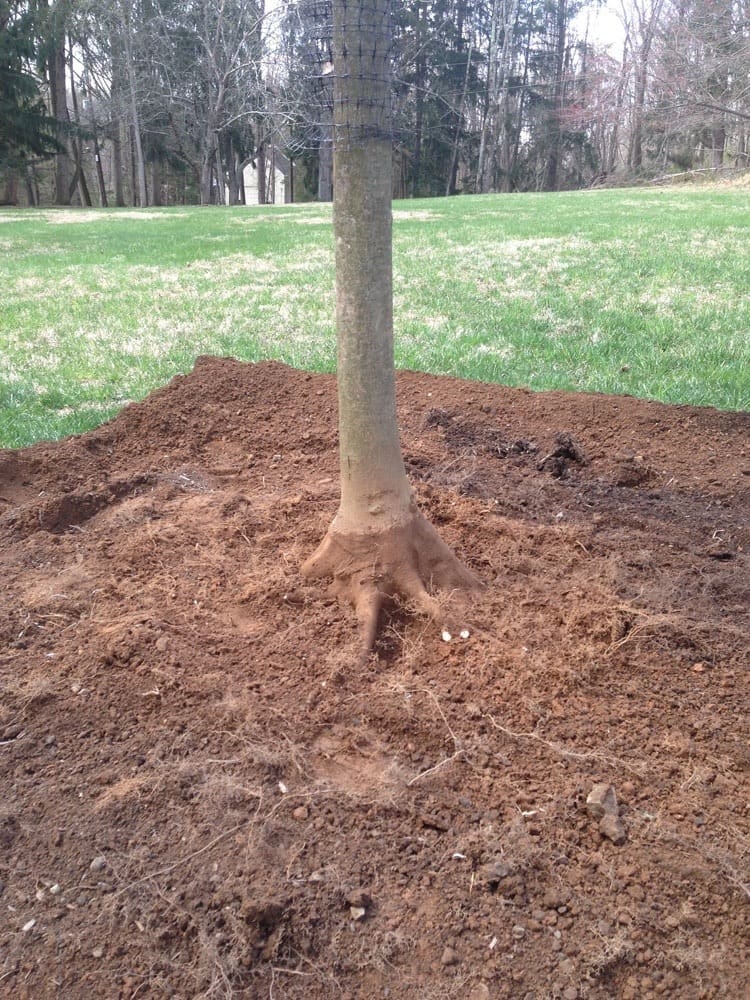
What is the root flare and why is it one of the most important things to know when planting?
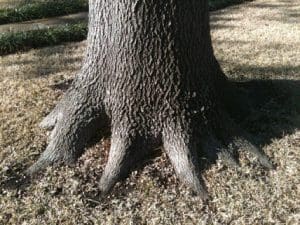 We plant a lot of trees mostly balled and burlapped or B&B, along with some smaller ones in containers. The industry adage has always been “better high than die”, meaning it is better to set the top of the root ball higher than the surrounding grade.
We plant a lot of trees mostly balled and burlapped or B&B, along with some smaller ones in containers. The industry adage has always been “better high than die”, meaning it is better to set the top of the root ball higher than the surrounding grade.
If we were to plant a B&B tree so that the top of the root ball was 1-2” above the surrounding grade would it be right? You can’t plant a tree and expect it to thrive if you don’t know where the root flare is. The root flare is where the tree trunk meets the roots and “flares” out. This could be at the top of the root ball or 5” below the top of the root ball. If it were 5” below and we planted the tree 1-2” high, we would actually be planting the tree 3-4” too low.
What’s the beg deal with planting the tree too low? Will my tree die? The answer to that question is a definite maybe. If you plant a tree low, it can develop a secondary root system to compensate for the lack of moisture should be receiving. The secondary roots grow toward the surface rather than out from the tree. There is also the chance that these secondary roots can become girdling roots that can slowly choke the tree to death. Trees planted too deeply are also susceptible to truck rot and primary root suffocation. This situation can also develop even if the tree is planted properly, when too much mulch is put around the tree. This is typically termed a mulch volcano.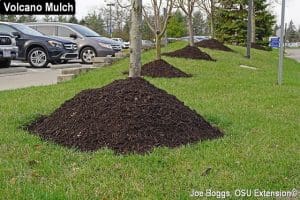
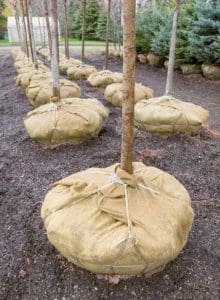
Typically a B&B tree has a wire basket, burlap, and sisal twine to secure the tree in the basket and keep the root ball tight, so how are you supposed to know where the root flare is when everything is all wrapped up? We cut away some of the burlap, without cutting the sisal twine and do some preliminary digging to find the flare. We can then dig the hole to the proper depth so that the root flare is set a few inches above the surrounding grade. Once the tree is in the hole, we can cut away the sisal and burlap and excavate the necessary soil from the top of the root ball. If there are any secondary roots, they should be removed at this time along with any girdling roots.
Although this is common for B&B trees it can also be common in container plants as well. We planted a Japanese holly hedge about 6 years ago and every plant was buried 5-6” requiring us to remove that excess potting media and secondary roots. There plants were in #15 containers, they were large and there were quite a few of them. I am happy to say they all look great and have continued to thrive, if we had not noticed the issue it is likely that we might have had to rip them out and replace them.
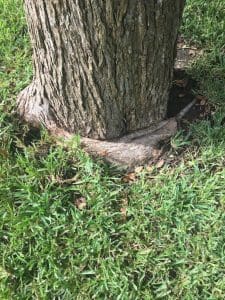 The effects from planting improperly won’t show up right away, it could be years or decades. Imagine you planted a tree for shade on your patio 10 -15 years ago. The tree has matured nicely, but maybe took longer than anticipated. Now it is starting to thin and just doesn’t look that great. You have an arborist evaluate the tree and they tell you it was planted too deep, the girdling roots are slowly choking it to death and it has to be removed, losing the shade on your patio all because it was planted incorrectly. Trees should never look like a telephone pole coming out of the ground and roots wrapping around a tree are a sure sign that this tree is not going to live a long healthy life.
The effects from planting improperly won’t show up right away, it could be years or decades. Imagine you planted a tree for shade on your patio 10 -15 years ago. The tree has matured nicely, but maybe took longer than anticipated. Now it is starting to thin and just doesn’t look that great. You have an arborist evaluate the tree and they tell you it was planted too deep, the girdling roots are slowly choking it to death and it has to be removed, losing the shade on your patio all because it was planted incorrectly. Trees should never look like a telephone pole coming out of the ground and roots wrapping around a tree are a sure sign that this tree is not going to live a long healthy life.

Discuss Your Dreams With Us
Your landscape and the time you spend there has untold potential. Bring it forth with a custom design and professional maintenance, and give yourself the freedom to enjoy the outdoors without hassle. Contact us today to get started on your project in Fort Washington, Pennsylvania, and throughout the tri-county area.